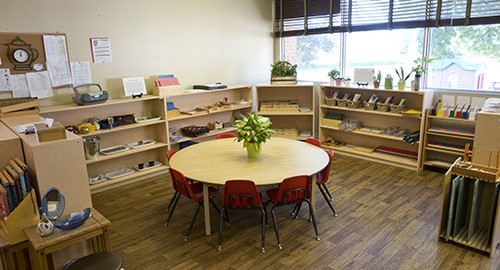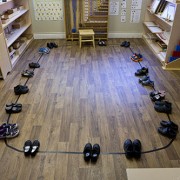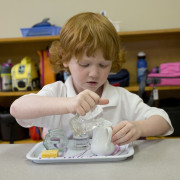Montessori Environment Enriches Learning and Development
If you have been following our blog, you have likely heard us mention the “prepared environment” in reference to our classrooms. This concept is central to authentic Montessori education, so we will explore it in more detail this week.
A Montessori classroom is designed with great care. At first glance, the classroom looks neat and tidy – almost sparse. Upon closer inspection, you will see the classroom is filled with a variety of carefully selected materials and activities. Everything has a purpose and a clearly defined home. In addition to being orderly, the space is designed to be visually appealing. Plants, natural light, and fine art are commonly found in a Montessori classroom.
However, the arrangement, planning and intent of a Montessori classroom goes so much deeper than the visual aesthetics. Dr. Montessori knew that the classroom environment could facilitate independent learning and discovery when the space was well planned and arranged to support children. She used the term the Prepared Environment to explain her approach to the arrangement and set up of a classroom.
“The first aim of the prepared environment is, as far as it is possible, to render the growing child independent of the adult.”
– Maria Montessori. The Secret of Childhood, 1966
Everything in a Montessori classroom is intentionally placed to elicit a positive response and invoke learning in the child. Materials are accessible on open shelves, arranged on trays to easily transition to a work station. A large carpeted area and child sized furnishings provide ample space and options for students to work comfortably. The prepared environment provides a natural sense of order which permeates the classroom and students are afforded a high degree of independence as a result. A calm yet industrious buzz of activity ensues.
Guiding Principles of the Prepared Environment
1. Freedom
The classroom and all of its contents are available to the students throughout the day. The classroom materials are spread out through the classroom to allow children the opportunity to move freely through the classroom – children can work at a table, on the floor, standing, etc.
2. Structure and Order
Dr. Montessori stated that there is a sensitive period for order for children between the ages of 1-3. During these early years, the order of the classroom provides an introduction and a methodology for students to make sense of their world.
3. Beauty
The Montessori classroom should be beautiful, warm and inviting. A tranquil environment will encourage the child to be calm; the beautiful room will encourage a child to take care of it.
4. Nature and Reality
The best way for children to learn about the world is to go out and experience it! In Montessori education, children are exposed to the Culture area of the classroom where they explore concepts and information about their environment and the greater world at an early age. This approach supports an appreciation and understanding of the environment, our community and the broader global community that makes up our home. A desire to care for the environment and each other is a natural extension.
5. Social Environment
The freedom and self-discipline within the classroom environment encourages children to interact with their peers. Classrooms consisting of students from a three-year age span enable younger students to rely on older peers for guidance and support. The elder students are then able to be role models and leaders for their younger classmates. This reciprocal dynamic benefits all ages in developing confidence, self-esteem, empathy and learning to work in groups.
6. Intellectual Environment
In addition to the five areas of the classroom (Practical Life, Sensorial, Math, Language and Culture) that stimulate the child’s intellect, overall growth and development culminates with the combination of all of the preceding components (1-5).
Our Prepared Environment at Kendalwood
The Kendalwood campus is a reflection of our commitment to the Montessori Method and the guiding principles of the prepared environment. We offer warm and inviting classrooms with an abundance of natural light, gleaming hardwood floors, and personalized cubbies. The entire campus is exceptionally bright and airy, creating an idyllic Montessori learning environment. Spacious outdoor areas include a wide open soccer field and multiple play areas with safe and age appropriate equipment. This backdrop regularly extends our classrooms to the outdoors. Our campus also offers a large, flexible space for indoor athletics, group learning and school wide activities.
The Kendalwood environment allows our students to be the centre of their own learning, in a space made specifically for the students. Are you looking for a place for your child to be inspired? Drop in to our next Open House or book a tour to see us in action! We are located in Whitby, Ontario in the heart of Durham Region.



